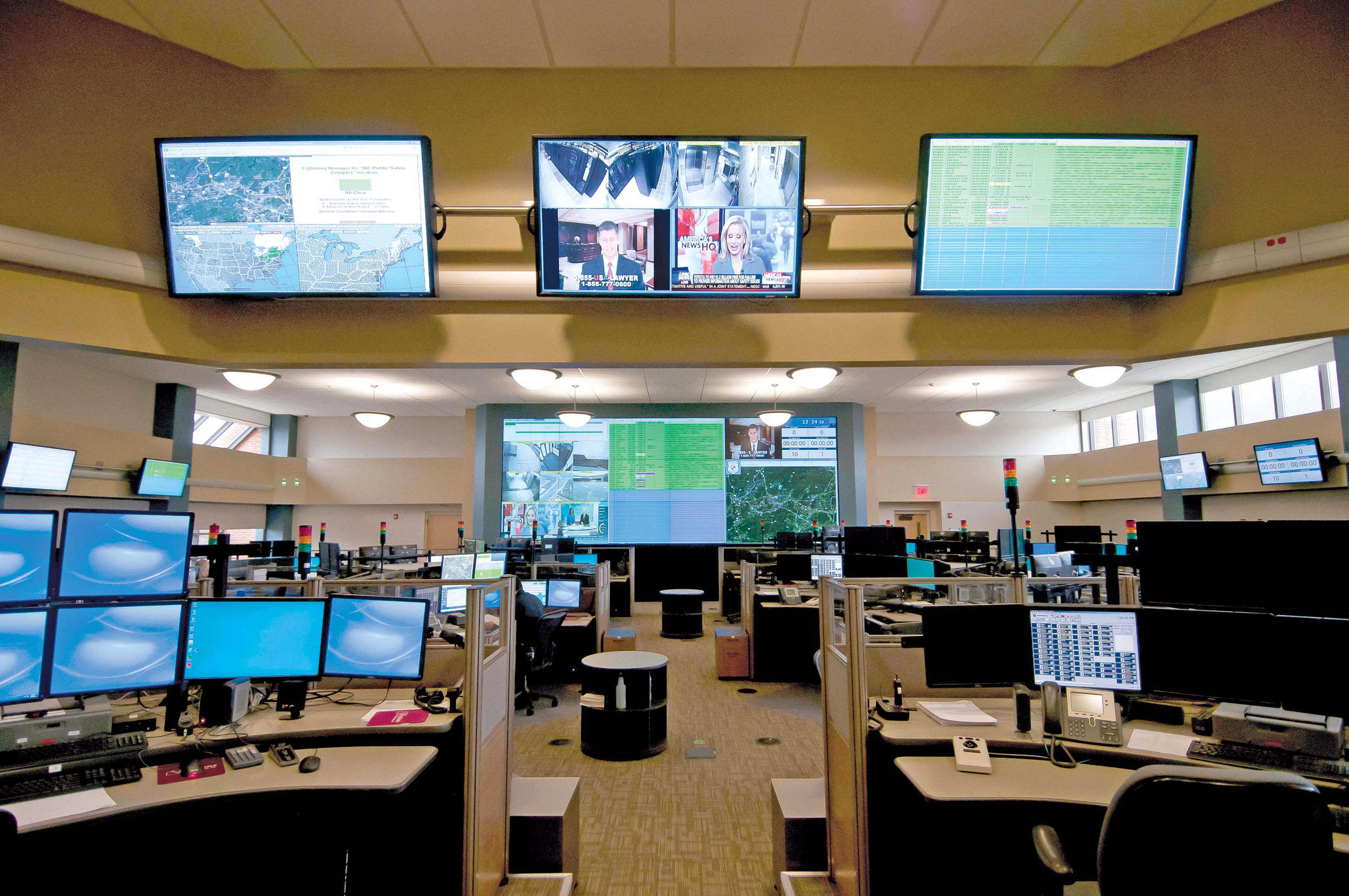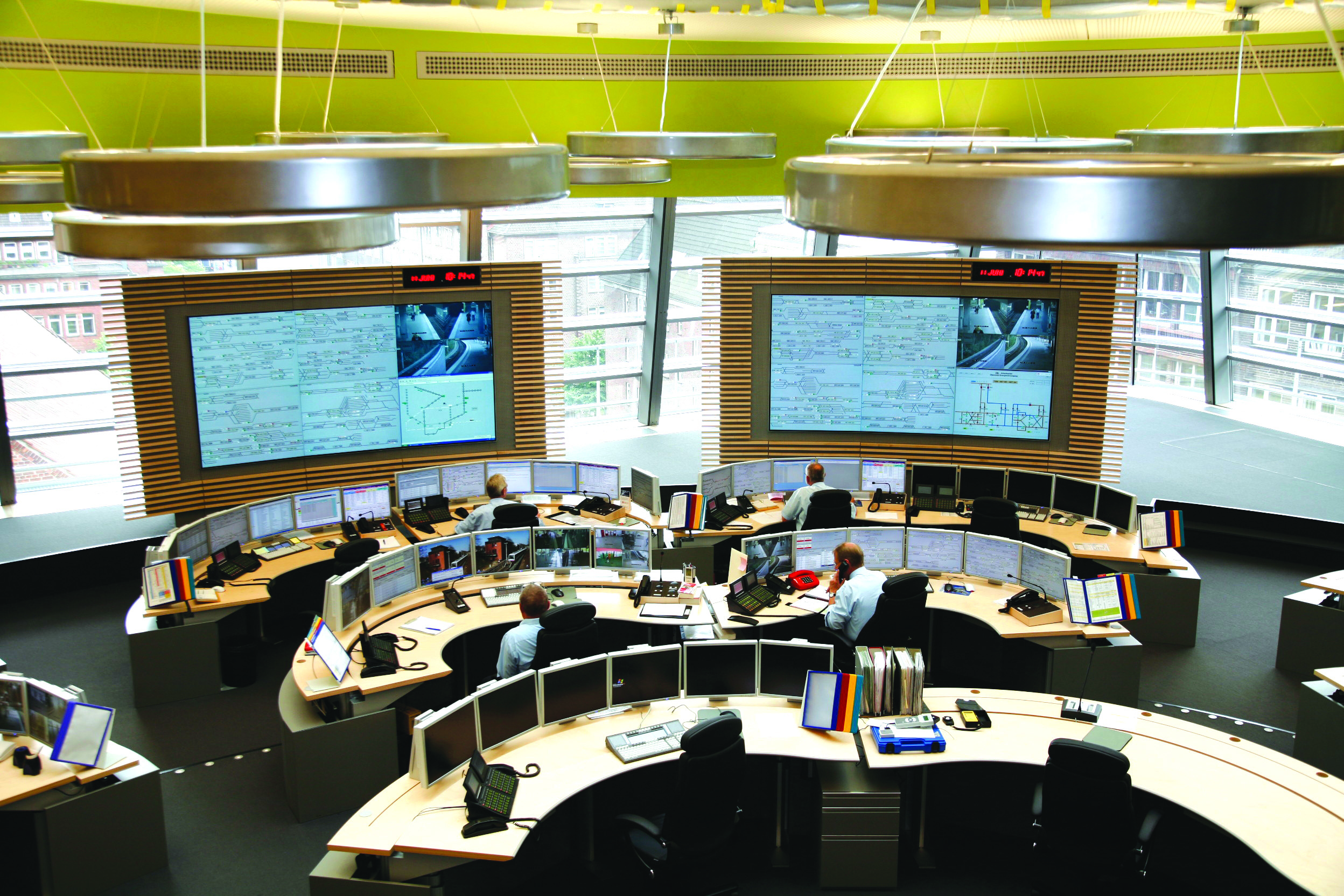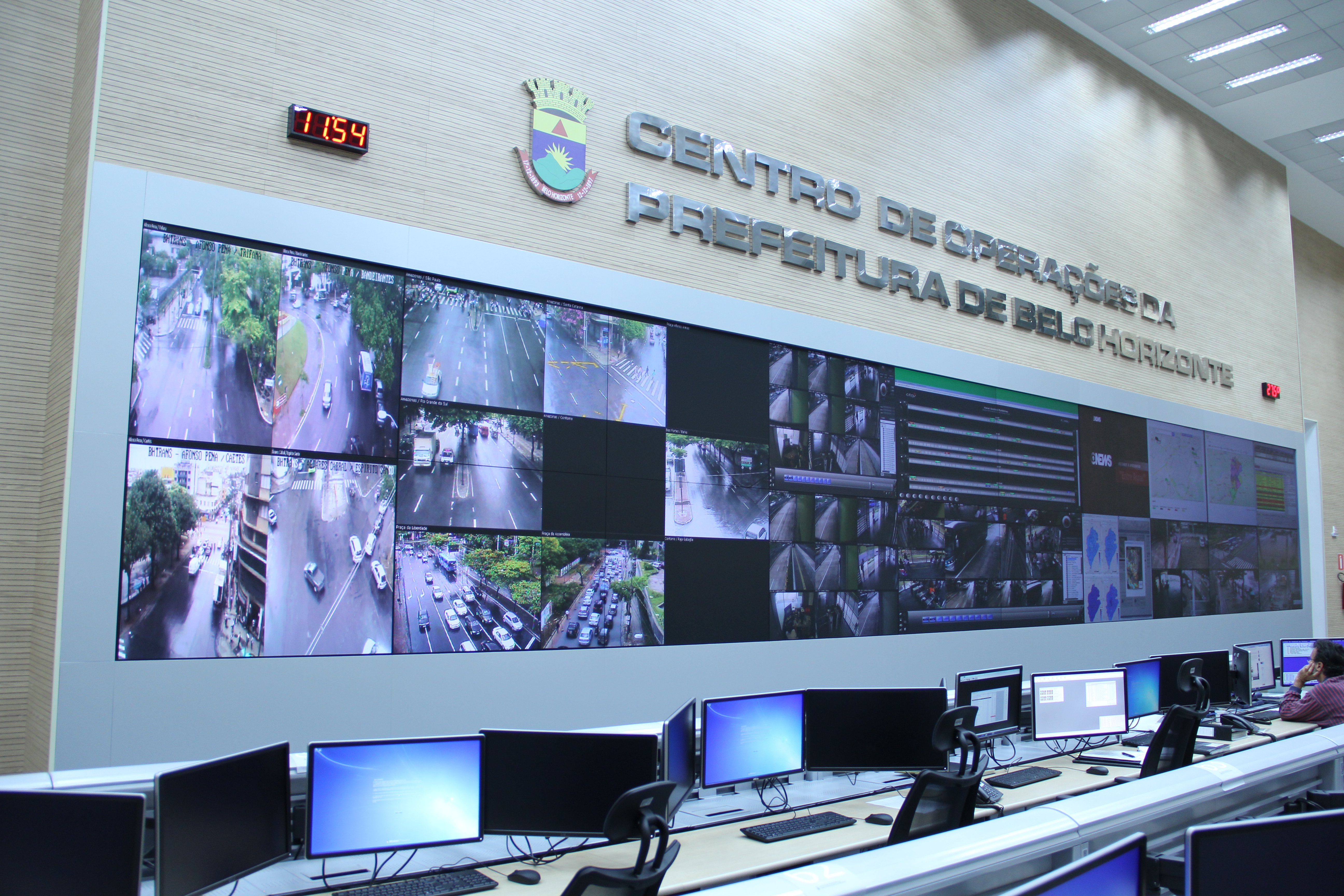Mitsubishi and Activu team up to help New Jersey emergency centre with real-time situational awareness. Sandy was the largest Atlantic hurricane in recorded history, with winds spanning an area of 1,100 miles and damages estimated at $68 billion. It killed at least 286 people in seven countries, from Jamaica to the Jersey Shore. But tropical storms are not the only challenge for emergency operations up and down the East Coast.

The full range of displays provides staff with an overview
Mitsubishi and Activu team up to help New Jersey emergency centre with real-time situational awareness.
Sandy was the largest Atlantic hurricane in recorded history, with winds spanning an area of 1,100 miles and damages estimated at $68 billion. It killed at least 286 people in seven countries, from Jamaica to the Jersey Shore.
But tropical storms are not the only challenge for emergency operations up and down the East Coast.
According to Scott Di Giralomo, director of the Department of Law and Public Safety for Morris County, New Jersey, communities must be prepared for major winter storms, fires, criminal activities and even earthquakes as the county rests on a large, if inactive, seismic fault. Emergency planning must also include contingency provisions to deal with acts of terrorism.
Planning for Morris County’s new emergency management facility started in 2007 and it began operations last October using some advanced visualisation and communications technology, including a command and control system designed by Activu.
“The ability to see the entire situation and act intelligently based on the facts is crucial to an operation like this,” says Paul Johrden, regional sales manager for software and integration company4220 Activu which specialises in network-based, large-scale visualisation and collaboration systems. At Morris County the systems include two large display walls using 30 4962 Mitsubishi rear-projection cubes powered by the company’s latest low-maintenance LED light engines.
The new facility was built as an addition to a public safety complex which provides services to nearly every community in Morris County. The addition includes two major control rooms for emergency management.
The Emergency Communications Centre (ECC) serves as a combination 911 call centre and a dispatch room for the police, fire and emergency medical services in 23 participating towns. It is continuously manned by up to 36 public safety operators each with their own communication consoles. A three-high by six-wide display wall comprises of eighteen 179cm (67in) Mitsubishi XGA rear-projection cubes to provide at-a-glance view of all emergency activity going on in the county.
Information sources include weather and news feeds, cameras in emergency vehicles and aircraft, traffic cameras and some security systems. “We also use an application called Mutual Link, so that first responders with iPads can stream still and video images to us from the scene of an accident or crime, and we can stream images back to them,” Di Giralomo explains.
“In addition, we have relationships with various organisations that can provide feeds from their facilities during certain events. For example, if there’s an incident in a school, they can turn their security cameras over to us, and we can relay those images to tactical teams and command posts.”
The display wall routinely shows statistical information on the number of 911 calls being processed, the status of the radio systems, a summary of open events, which emergency units have been assigned and GPS locations of emergency vehicles throughout the county. Using this information, ECC staff can find the nearest available responder to an incident and forward any calls while the Centre’s supervisors can see at a glance the status of their staff, immediately bringing additional resources in as needed.
Also in the space are 12 individual 132cm (52in) flat panels. These display additional information while the ECC supervisor, operations manager, chief of telecommunications and ECC director each have one or more 132cm (52in) displays in their work areas, all of which can take feeds from the Activu network.
“The challenge in building a system like this,” Johrden says, “is pulling all of the right information together.” Because many of the necessary data feeds are very sensitive and running on a secure network, it requires a specialist to aggregate them into a stream of useful visual information that can be shared across different locations and devices.
There is also an Emergency Operations Centre (EOC) which accesses the same network sources. It serves as a large-scale emergency and large event command centre and, when needed, is opened in addition to the ECC.
The EOC can accommodate up to 85 people, each with their own laptop or tablet, phone and/or radio. Depending on the type of emergency, these might include representatives of the police, fire, emergency medical services, utility companies, human services agencies, the National Guard, political leadership and even local businesses or chambers of commerce. They are seated at tables which can be configured in three different ways, each position with AC power plus wired and wireless access to various public and private-sector networks.
Inside the EOC is a display wall consisting of twelve 179cm (67 inch) Mitsubishi projection cubes in a two high by six wide configuration to display information critical to a ‘common operating picture’ for those working on the emergency. Eight additional 132cm (52 inch) flat-panel displays are available for specific informational sources, and two interactive whiteboards connect to other whiteboards in the building as well as the Activu display network.
“One of the lessons we learned from Hurricane Sandy was that an emergency can be larger than any EOC can accommodate,” Di Giralomo says. For that reason, the network includes two breakout rooms and a situation room with 132cm (52in) or 178cm (70in) displays plus 132cm (52 inch) displays in supervisors’ offices. “We can use these displays like mini-display walls of our own, giving one or two people the ability to view the entire situation,” he explains.
Di Giralomo says a crucial concern in the development of the emergency centre was its ability to function under any conditions. “We built the facility to withstand earthquakes as well as major storms,” he explains. “It also had to be ready for simple things like electrical and water system failures. We included redundancy in the building’s heating, ventilation and air conditioning systems, so that our people could continue working through catastrophic events even in very hot or freezing weather.”
In the same way, the systems had to be exceptionally reliable, since it might not be possible to replace a device or even secure the help of a technician during an emergency.
“We also worried about maintenance costs,” Di Giralomo adds. “In government, you never know what your funding situation will be even two or three years down the road. We knew we had our capital investment covered, but we did not want to invest all of this time, money and effort only to find our operating budget cut to a point where we could not keep these systems running.”
For those reasons, Mitsubishi’s latest LED-based projection cubes were extremely attractive to the county as their expected useful life is more than 80,000 hours, or between nine to 11 years of continuous use.
Johrden adds that, even when the Mitsubishi cubes reach the end of their service life, they can be updated by exchanging the light engines. “There’s no need to replace the infrastructure, cabling, software, or even rebuild the wall itself. You can open up the cabinets, swap out the light engines, and you’re good for another nine years or more.”
Another crucial advantage of the LED-based cubes is that they run far cooler than lamp-based units. “Not only do they cut the county’s energy costs, but they made it possible to create much smaller HVAC and AC power backup systems than would have otherwise been required,” Johrden explains. The reduced need for infrastructure fits well with Di Giralomo’s goal of keeping long-term maintenance costs at a minimum.
Di Giralomo says the county has been extremely pleased with the performance of the Activu systems so far. While it’s true that there has not been a large-scale emergency like Hurricane Sandy, they use the EOC regularly for exercises and manned it during Super Bowl XLVIII, which took place in nearby Bergen County. Throughout the Super Bowl weekend, the EOC was used to help handle the increase in traffic and prepare for any crowd-related emergencies.
The region has big plans for additional emergency centres. According to Di Giralomo, the Morris County EOC was created as part of an initiative to link emergency facilities in seven New Jersey counties and two large cities via Activu systems. “Once all of these centres are installed, we will have the ability to share our network feeds and real-time situational awareness with each of them. If there is a problem in Newark, for example, we will be able to help support them, and they will be able to support us.”
Sandy was the largest Atlantic hurricane in recorded history, with winds spanning an area of 1,100 miles and damages estimated at $68 billion. It killed at least 286 people in seven countries, from Jamaica to the Jersey Shore.
But tropical storms are not the only challenge for emergency operations up and down the East Coast.
According to Scott Di Giralomo, director of the Department of Law and Public Safety for Morris County, New Jersey, communities must be prepared for major winter storms, fires, criminal activities and even earthquakes as the county rests on a large, if inactive, seismic fault. Emergency planning must also include contingency provisions to deal with acts of terrorism.
Planning for Morris County’s new emergency management facility started in 2007 and it began operations last October using some advanced visualisation and communications technology, including a command and control system designed by Activu.
“The ability to see the entire situation and act intelligently based on the facts is crucial to an operation like this,” says Paul Johrden, regional sales manager for software and integration company
County-wide emergency management
Morris County covers 1,250km2 (4802mi2) of north-central New Jersey directly west of New York City. It has a population of about 492,000 and its largest towns include Parsippany, Troy Hills and Rockaway.The new facility was built as an addition to a public safety complex which provides services to nearly every community in Morris County. The addition includes two major control rooms for emergency management.
The Emergency Communications Centre (ECC) serves as a combination 911 call centre and a dispatch room for the police, fire and emergency medical services in 23 participating towns. It is continuously manned by up to 36 public safety operators each with their own communication consoles. A three-high by six-wide display wall comprises of eighteen 179cm (67in) Mitsubishi XGA rear-projection cubes to provide at-a-glance view of all emergency activity going on in the county.
Information sources include weather and news feeds, cameras in emergency vehicles and aircraft, traffic cameras and some security systems. “We also use an application called Mutual Link, so that first responders with iPads can stream still and video images to us from the scene of an accident or crime, and we can stream images back to them,” Di Giralomo explains.
“In addition, we have relationships with various organisations that can provide feeds from their facilities during certain events. For example, if there’s an incident in a school, they can turn their security cameras over to us, and we can relay those images to tactical teams and command posts.”
The display wall routinely shows statistical information on the number of 911 calls being processed, the status of the radio systems, a summary of open events, which emergency units have been assigned and GPS locations of emergency vehicles throughout the county. Using this information, ECC staff can find the nearest available responder to an incident and forward any calls while the Centre’s supervisors can see at a glance the status of their staff, immediately bringing additional resources in as needed.
Also in the space are 12 individual 132cm (52in) flat panels. These display additional information while the ECC supervisor, operations manager, chief of telecommunications and ECC director each have one or more 132cm (52in) displays in their work areas, all of which can take feeds from the Activu network.
“The challenge in building a system like this,” Johrden says, “is pulling all of the right information together.” Because many of the necessary data feeds are very sensitive and running on a secure network, it requires a specialist to aggregate them into a stream of useful visual information that can be shared across different locations and devices.
There is also an Emergency Operations Centre (EOC) which accesses the same network sources. It serves as a large-scale emergency and large event command centre and, when needed, is opened in addition to the ECC.
The EOC can accommodate up to 85 people, each with their own laptop or tablet, phone and/or radio. Depending on the type of emergency, these might include representatives of the police, fire, emergency medical services, utility companies, human services agencies, the National Guard, political leadership and even local businesses or chambers of commerce. They are seated at tables which can be configured in three different ways, each position with AC power plus wired and wireless access to various public and private-sector networks.
Inside the EOC is a display wall consisting of twelve 179cm (67 inch) Mitsubishi projection cubes in a two high by six wide configuration to display information critical to a ‘common operating picture’ for those working on the emergency. Eight additional 132cm (52 inch) flat-panel displays are available for specific informational sources, and two interactive whiteboards connect to other whiteboards in the building as well as the Activu display network.
“One of the lessons we learned from Hurricane Sandy was that an emergency can be larger than any EOC can accommodate,” Di Giralomo says. For that reason, the network includes two breakout rooms and a situation room with 132cm (52in) or 178cm (70in) displays plus 132cm (52 inch) displays in supervisors’ offices. “We can use these displays like mini-display walls of our own, giving one or two people the ability to view the entire situation,” he explains.
Ready for anything
Di Giralomo says a crucial concern in the development of the emergency centre was its ability to function under any conditions. “We built the facility to withstand earthquakes as well as major storms,” he explains. “It also had to be ready for simple things like electrical and water system failures. We included redundancy in the building’s heating, ventilation and air conditioning systems, so that our people could continue working through catastrophic events even in very hot or freezing weather.”
In the same way, the systems had to be exceptionally reliable, since it might not be possible to replace a device or even secure the help of a technician during an emergency.
“We also worried about maintenance costs,” Di Giralomo adds. “In government, you never know what your funding situation will be even two or three years down the road. We knew we had our capital investment covered, but we did not want to invest all of this time, money and effort only to find our operating budget cut to a point where we could not keep these systems running.”
For those reasons, Mitsubishi’s latest LED-based projection cubes were extremely attractive to the county as their expected useful life is more than 80,000 hours, or between nine to 11 years of continuous use.
Johrden adds that, even when the Mitsubishi cubes reach the end of their service life, they can be updated by exchanging the light engines. “There’s no need to replace the infrastructure, cabling, software, or even rebuild the wall itself. You can open up the cabinets, swap out the light engines, and you’re good for another nine years or more.”
Another crucial advantage of the LED-based cubes is that they run far cooler than lamp-based units. “Not only do they cut the county’s energy costs, but they made it possible to create much smaller HVAC and AC power backup systems than would have otherwise been required,” Johrden explains. The reduced need for infrastructure fits well with Di Giralomo’s goal of keeping long-term maintenance costs at a minimum.
Di Giralomo says the county has been extremely pleased with the performance of the Activu systems so far. While it’s true that there has not been a large-scale emergency like Hurricane Sandy, they use the EOC regularly for exercises and manned it during Super Bowl XLVIII, which took place in nearby Bergen County. Throughout the Super Bowl weekend, the EOC was used to help handle the increase in traffic and prepare for any crowd-related emergencies.
The region has big plans for additional emergency centres. According to Di Giralomo, the Morris County EOC was created as part of an initiative to link emergency facilities in seven New Jersey counties and two large cities via Activu systems. “Once all of these centres are installed, we will have the ability to share our network feeds and real-time situational awareness with each of them. If there is a problem in Newark, for example, we will be able to help support them, and they will be able to support us.”










